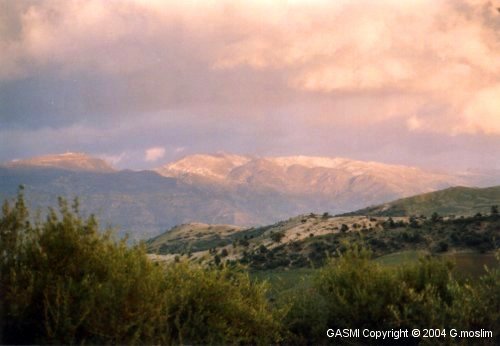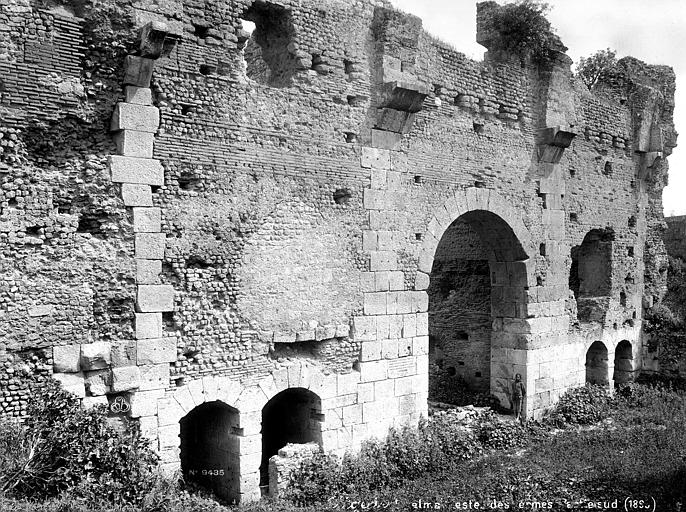|
Guelma
Guelma ( ar, قالمة ''Qālima''; arq, ڨالمة; Algerian pronunciation: ) is the capital of Guelma Province and Guelma District, located in north-eastern Algeria, about 65 kilometers from the Mediterranean coast. Its location corresponds to that of ancient Calama. History Antiquity Though Guelma was settled from early prehistory, it was first established as a town under the Phoenicians, who called it ''Malaca'', probably a Phoenician word meaning "salt" (sharing a common etymology with '' Málaga'' in Spain). Later, the Romans settled the area and renamed it '' Calama'', part of the Roman province of Numidia. Calama prospered during the rise of Christianity; Saint Possidius was bishop of Guelma during the 5th century. Later, the Vandal invasion devastated the area until the coming of the Byzantines, who settled the area and built city walls to protect it from further invasions. It was located in the Byzantine Exarchate of Africa. However, after the successfu ... [...More Info...] [...Related Items...] OR: [Wikipedia] [Google] [Baidu] |
Guelma Station
Guelma ( ar, قالمة ''Qālima''; arq, ڨالمة; Algerian pronunciation: ) is the capital of Guelma Province and Guelma District, located in north-eastern Algeria, about 65 kilometers from the Mediterranean coast. Its location corresponds to that of ancient Calama. History Antiquity Though Guelma was settled from early prehistory, it was first established as a town under the Phoenicians, who called it ''Malaca'', probably a Phoenician word meaning " salt" (sharing a common etymology with ''Málaga'' in Spain). Later, the Romans settled the area and renamed it '' Calama'', part of the Roman province of Numidia. Calama prospered during the rise of Christianity; Saint Possidius was bishop of Guelma during the 5th century. Later, the Vandal invasion devastated the area until the coming of the Byzantines, who settled the area and built city walls to protect it from further invasions. It was located in the Byzantine Exarchate of Africa. However, after the succ ... [...More Info...] [...Related Items...] OR: [Wikipedia] [Google] [Baidu] |
Guelma Province
Guelma Province ( ar, ولاية قالمة) is a province ('' wilaya'') in eastern Algeria. Its namesake is its seat and most populous municipality: Guelma. History Its civilians suffered heavy casualties during the 1945 Sétif massacre by the French Army. The province itself was established in 1974. Before that, it was part of Annaba Province. In 1984 El Taref Province and Souk Ahras Province were carved out of its territory. Demographics It has 429,998 inhabitants as of the 1998 census, one of the lower populations in the country, which gives it 39 seats in the APW, the province's assembly. The population density is . Of these, 54.4% live in urban areas and 87% have access to safe drinking water, lower than the national average of 89%. Of the active population of the province, 23.3% work in agriculture, 17.9% in constructions, 9.9% in industry, and 48.9% in the services sector. 21.1% of the population is unemployedbr> Geography The territory of the province () is ma ... [...More Info...] [...Related Items...] OR: [Wikipedia] [Google] [Baidu] |
Guelma District
Guelma District is an Algerian district in Guelma Province, in northeastern Algeria. The District was named after its capital city, Guelma, which is also the capital of the Province. The district has several Ancient Roman archaeological sites. Municipalities The District is further divided into 2 municipalities, which is the lowest number per district subdivision in the Province: *Guelma Municipality — ''capital city''. *Ben Djerrah Ben Djerrah is a municipality in Guelma province, Algeria. It is located in Guelma district, to the southwest of the nearby city of Guelma. Its main settlement is the town of Ben Djerrah, even though the suburban sprawl of Guelma Guelma ( ar, ... Municipality References Districts of Guelma Province {{Guelma-geo-stub ... [...More Info...] [...Related Items...] OR: [Wikipedia] [Google] [Baidu] |
Calama (Numidia)
Calama was a '' colonia'' in the Roman province of Numidia situated where Guelma in Algeria now stands. G. Mokhtar places it just within the Roman province of Africa Proconsularis, to the east of Numidia,G. Mokhtar, ''General History of Africa II: Ancient Civilizations of Africa'' (UNESCO 1981 ), pp. 470–471 an [...More Info...] [...Related Items...] OR: [Wikipedia] [Google] [Baidu] |
Provinces Of Algeria
Algeria, since December 18, 2019, is divided into 58 wilayas ( provinces). Prior to December 18, 2019, there were 48 provinces. The 58 provinces are divided into 1,541 baladiyahs ( municipalities). The name of a province is always that of its capital city. According to the Algerian constitution, a wilaya is a territorial collectivity enjoying economic and diplomatic freedom, the APW, or ''"Popular Provincial Parliament/Provincial Popular Parliament"'' (the ''Assemblée Populaire Wilayale'', in French) is the political entity governing a province, directed by the " Wali" ( Governor), who is chosen by the Algerian President to handle the APW's decisions, the APW has also a president, who is elected by the members of the APW, which Algerians elect. List By 1984 the number of Algerian provinces were fixed at 48 and established the list of municipalities or "communes" attached to each province. In 2019, 10 new provinces were added. The province numbers are the first 31 province ... [...More Info...] [...Related Items...] OR: [Wikipedia] [Google] [Baidu] |
Saint Possidius
Possidius (5th century) was a friend of Augustine of Hippo who wrote a reliable biography and an ''indiculus'' or list of his works. He was bishop of Calama in the Roman province of Numidia. Biography The dates of his birth and death are unknown. In the ''Vita S. Augustini'' (xxxi), after describing the death of Augustine, Possidius speaks of his unbroken friendship with him for forty years. He also, speaking of himself in the third person, lets it be known that he was one of the clergy of Augustine's monastery.Bacchus, Francis Joseph. "St. Possidius." The Catholic Encyclopedia Vol. 12. New York: Robert Appleton Company, 1911. 10 January 2020 The date of his promotion to the episcopate was, according to [...More Info...] [...Related Items...] OR: [Wikipedia] [Google] [Baidu] |
Algeria
) , image_map = Algeria (centered orthographic projection).svg , map_caption = , image_map2 = , capital = Algiers , coordinates = , largest_city = capital , religion = , official_languages = , languages_type = Other languages , languages = Algerian Arabic (Darja)French , ethnic_groups = , demonym = Algerian , government_type = Unitary semi-presidential republic , leader_title1 = President , leader_name1 = Abdelmadjid Tebboune , leader_title2 = Prime Minister , leader_name2 = Aymen Benabderrahmane , leader_title3 = Council President , leader_name3 = Salah Goudjil , leader_title4 = Assembly President , leader_name4 = Ibrahim Boughali , legislature = Parliament , upper_house = Council of the Nation , lowe ... [...More Info...] [...Related Items...] OR: [Wikipedia] [Google] [Baidu] |
Roman Province
The Roman provinces (Latin: ''provincia'', pl. ''provinciae'') were the administrative regions of Ancient Rome outside Roman Italy that were controlled by the Romans under the Roman Republic and later the Roman Empire. Each province was ruled by a Roman appointed as governor. For centuries it was the largest administrative unit of the foreign possessions of ancient Rome. With the administrative reform initiated by Diocletian, it became a third level administrative subdivision of the Roman Empire, or rather a subdivision of the imperial dioceses (in turn subdivisions of the imperial prefectures). Terminology The English word ''province'' comes from the Latin word ''provincia''. In early Republican times, the term was used as a common designation for any task or set of responsibilities assigned by the Roman Senate to an individual who held '' imperium'' (right of command), which was often a military command within a specified theatre of operations. In time, the term beca ... [...More Info...] [...Related Items...] OR: [Wikipedia] [Google] [Baidu] |
Numidia
Numidia ( Berber: ''Inumiden''; 202–40 BC) was the ancient kingdom of the Numidians located in northwest Africa, initially comprising the territory that now makes up modern-day Algeria, but later expanding across what is today known as Tunisia, Libya, and some parts of Morocco. The polity was originally divided between the Massylii in the east and the Masaesyli in the west. During the Second Punic War (218–201 BC), Masinissa, king of the Massylii, defeated Syphax of the Masaesyli to unify Numidia into one kingdom. The kingdom began as a sovereign state and later alternated between being a Roman province and a Roman client state. Numidia, at its largest extent, was bordered by Mauretania to the west, at the Moulouya River, Africa Proconsularis to the east, the Mediterranean Sea to the north, and the Sahara to the south. It was one of the first major states in the history of Algeria and the Berbers. History Independence The Greek historians referred to these peopl ... [...More Info...] [...Related Items...] OR: [Wikipedia] [Google] [Baidu] |
Christianity
Christianity is an Abrahamic monotheistic religion based on the life and teachings of Jesus of Nazareth Jesus, likely from he, יֵשׁוּעַ, translit=Yēšūaʿ, label=Hebrew/Aramaic ( AD 30 or 33), also referred to as Jesus Christ or Jesus of Nazareth (among other names and titles), was a first-century Jewish preacher and religious .... It is the Major religious groups, world's largest and most widespread religion with roughly 2.38 billion followers representing one-third of the global population. Its adherents, known as Christians, are estimated to make up a majority of the population in Christianity by country, 157 countries and territories, and believe that Jesus in Christianity, Jesus is the Son of God (Christianity), Son of God, whose coming as the Messiah#Christianity, messiah was Old Testament messianic prophecies quoted in the New Testament, prophesied in the Hebrew Bible (called the Old Testament in Christianity) and chronicled in the New Testamen ... [...More Info...] [...Related Items...] OR: [Wikipedia] [Google] [Baidu] |
Vandal
The Vandals were a Germanic people who first inhabited what is now southern Poland. They established Vandal kingdoms on the Iberian Peninsula, Mediterranean islands, and North Africa in the fifth century. The Vandals migrated to the area between the lower Oder and Vistula rivers in the second century BC and settled in Silesia from around 120 BC. They are associated with the Przeworsk culture and were possibly the same people as the Lugii. Expanding into Dacia during the Marcomannic Wars and to Pannonia during the Crisis of the Third Century, the Vandals were confined to Pannonia by the Goths around 330 AD, where they received permission to settle from Constantine the Great. Around 400, raids by the Huns from the east forced many Germanic tribes to migrate west into the territory of the Roman Empire and, fearing that they might be targeted next, the Vandals were also pushed westwards, crossing the Rhine into Gaul along with other tribes in 406. In 409, the Vandals cros ... [...More Info...] [...Related Items...] OR: [Wikipedia] [Google] [Baidu] |
Spain
, image_flag = Bandera de España.svg , image_coat = Escudo de España (mazonado).svg , national_motto = '' Plus ultra'' ( Latin)(English: "Further Beyond") , national_anthem = (English: "Royal March") , image_map = , map_caption = , image_map2 = , capital = Madrid , coordinates = , largest_city = Madrid , languages_type = Official language , languages = Spanish , ethnic_groups = , ethnic_groups_year = , ethnic_groups_ref = , religion = , religion_ref = , religion_year = 2020 , demonym = , government_type = Unitary parliamentary constitutional monarchy , leader_title1 = Monarch , leader_name1 = Felipe VI , leader_title2 = Prime Minister , leader_name2 = Pedro Sánchez , legislature = ... [...More Info...] [...Related Items...] OR: [Wikipedia] [Google] [Baidu] |






